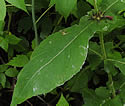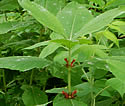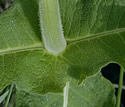Triosteum perfoliatum (Late Horse Gentian)
| Also known as: | Fever-wort, Wild Coffee |
|---|---|
| Genus: | Triosteum |
| Family: | Caprifoliaceae (Honeysuckle) |
| Life cycle: | perennial |
| Origin: | native |
| Habitat: | part shade, sun; dry woods, thickets, poor rocky soil |
| Bloom season: | May - June |
| Plant height: | 2 to 4 feet |
| Wetland Indicator Status: | none |
| MN county distribution (click map to enlarge): |  |
| National distribution (click map to enlarge): |  |
Pick an image for a larger view. See the glossary for icon descriptions.
Detailed Information
Flower: 


![[photo of flowers]](/udata/r9ndp23q/pd/triosteum-perfoliatum-17-t.jpg) Clusters of 2 to 6 stalkless, tubular flowers in the leaf axils. Flowers are velvety, purple brown to red, ½ to ¾ inch long. Blossoms open up and angle outward mid-tube, ending in 5 round lobes with a conspicuous light green style protruding from the tube. The yellow stamens remain recessed below the lobes. The 5 sepals are covered in fine downy hairs, long and narrow and may be longer than the flower.
Clusters of 2 to 6 stalkless, tubular flowers in the leaf axils. Flowers are velvety, purple brown to red, ½ to ¾ inch long. Blossoms open up and angle outward mid-tube, ending in 5 round lobes with a conspicuous light green style protruding from the tube. The yellow stamens remain recessed below the lobes. The 5 sepals are covered in fine downy hairs, long and narrow and may be longer than the flower.
Leaves and stems: 

![[photo of leaves]](/udata/r9ndp23q/pd/triosteum-perfoliatum-18-t.jpg) Leaves are opposite, long and broad, 4 to 9 inches long, 2 to 4 inches wide, broadly oval elliptic tapering to a sharp tip, toothless with somewhat wavy edges, the surfaces softly hairy, especially on the underside. The base narrows abruptly, joining the opposite leaf base, usually completely encompassing the stem (perfoliate). Leaf pairs are at right angles to the pair below. The stem is unbranched, covered in short, soft hairs.
Leaves are opposite, long and broad, 4 to 9 inches long, 2 to 4 inches wide, broadly oval elliptic tapering to a sharp tip, toothless with somewhat wavy edges, the surfaces softly hairy, especially on the underside. The base narrows abruptly, joining the opposite leaf base, usually completely encompassing the stem (perfoliate). Leaf pairs are at right angles to the pair below. The stem is unbranched, covered in short, soft hairs.
Fruit: 
![[photo of fruit]](/udata/r9ndp23q/red/horse-gentian_0915_125300-t.jpg) Fruits are round to egg shaped, 1/3 to ½ inch long with the 5 long sepals arrayed from the end. The fleshy coat, turning a dull yellow orange when ripe, covers a large hard seed in the center (drupe).
Fruits are round to egg shaped, 1/3 to ½ inch long with the 5 long sepals arrayed from the end. The fleshy coat, turning a dull yellow orange when ripe, covers a large hard seed in the center (drupe).
Notes:
Late Horse Gentian grows in hardwood forest openings and margins along the tension zone between the drier southwestern prairie and the northeastern boreal forest, and is well adapted to both rich mesic soils and poorer gravelly ones. While lore has it that seeds were roasted and used as a coffee substitute, there is little evidence it was widely utilized in this manner and more likely the reputation simply came from the observation that the dried seeds bear a resemblance to coffee beans. A similar species is Early Horse Gentian (Triosteum aurantiacum) which has much the same flower except the green style does not extend out of the tube as far, has leaves that narrow at the base but do not encompass the stem (though this can be difficult to distinguish sometimes), and red-orange fruit. Early also has longer hairs on the stem than Late, but not dramatically so.
Native Plant Nurseries, Restoration and Landscaping Services ↓
More photos
Photos by K. Chayka taken in Hennepin, Washington and Dakota counties. Photos courtesy Peter M. Dziuk taken in Dakota and Hennepin counties.
Comments
Have you seen this plant in Minnesota, or have any other comments about it?
on: 2014-06-18 20:39:19
See on an old farm property that was once used as goat prairie. Was in bloom on 6/12/2014
on: 2014-10-06 16:43:23
I have a couple of these plants on our property. The land used to be a hay field, next to a cattle pasture. Now it is grass with black walnuts and oaks growing there. It took a while to find the name. There are berries along the stems.Is it poisonous? 10-6-14
on: 2015-10-18 12:18:36
I first noticed a healthy cluster of Triosteum perfoliatum two years ago along a trail through the Maple Grove park system. Since then the city has mowed most of it down. What is the legal status of this plant in Minnesota? 10/18/15
on: 2015-10-18 12:25:58
Mary Lynn, like most plants in MN, this has no special status. The landowner, whomever it may be, can do what they like with any population on their own land. However, they may not actually be aware of what native plants they have where, or that they are being mowed down at all. As a concerned citizen, you might contact the city Parks & Rec. and speak to someone about it.
on: 2015-10-19 08:52:06
Saw the telltale berries on this beautiful plant while on a hike at Frontenac State Park this weekend. It was very interesting how the berries came in different numbers at different levels. Some had six, five, four, or three.
on: 2015-11-08 07:44:51
Didn't know this plant but was happy to see it featured in a painting in the newest DNR Conservation Volunteer magazine to learn its name. Saw it and its yellow fruits last weekend on a walk through Greenvale Park Commmunity School's woods.
on: 2016-09-09 22:01:30
Discovered this unusual plant as a volunteer on my woodland property in a spot where landscapers had laid in a thick wood mulch. Thanks to the UofM Extension and UofM Herbarium at Bell Museum for identification. Look forward to continued propogation of this welcome volunteer plant.
on: 2017-06-30 09:13:31
Delighted to find this plant, already gone to seed, on a hike at Lost Valley Scientific and Natural Area. Love the star-shaped "after-bloom." I'd never seen it before; props to Karen Schik at Friends of the Mississippi River for identifying it for me by my awkward description.
on: 2018-05-17 09:56:40
Over the last decade we have been seeing more and more colonies of Late Horse Gentian growing in mature aspen-hardwood mix on our property. I can't recall seeing them prior to that but may have overlooked them in the past. Very striking plant.
on: 2018-08-29 22:27:10
These are in abundance right now on certain trails at Oxbow Park in Byron, MN. I am noticing more this year than last year.
on: 2018-11-21 00:01:10
These showed up in my wild yard area last year for the first time. Now I see another new patch a few hundred feet away. The orange berries in fall are very unique. I'm quite happy they like it here.
on: 2020-06-23 12:23:21
showed up in my full sun prairie garden, heavy clay soil.
on: 2020-06-26 12:12:52
On our dirt road side, growing amongst wild liatrus, just found the one plant.
on: 2020-07-01 14:30:03
Became a volunteer on our wooded property, had never seen it before. The Bell Museum helped me identify it in 2017, and since it has propogated vastly. I originally thought it came in with wood mulch, but may have propogated from interior woodland.
on: 2021-02-03 22:17:56
We have a small area of healthy prairie back behind our house, and this plant grows in abundance there. It forms nice clumps here and there between other wildflowers and grasses. It took me years to identify, but this site was actually how I finally ID'd it. It seems like it would spread more aggressively, but it seems to only grow moderately and plays nice with the other plants.
on: 2021-08-18 15:12:02
Two plants volunteered in our home prairie. The guys from Prairie Restoration identified it for me. Very Cool!
on: 2021-08-29 14:59:24
This plant grows in our forest near Lenora, MN. My son in law also found it in their woods near Fountain, MN. The orange berries in late summer are the best clue for me. I prefer the nickname of Coffee Berry - much easier to remember!
on: 2022-06-06 08:21:05
Just now photographing thru the scope and am reminded T. perfoliatum has sticky globules (for want of the proper botanical term) at the ends of some hairs on the underside of the leaves and veins. I find insects stuck, mostly parasitoid wasps. Perhaps worth mentioning. Oops, globules are on the upper side as well.
on: 2022-09-23 12:26:00
I've seen these in pastures, and shade, but consistently see them near or growing under Black Walnut trees. Found several hundred plants yesterday around walnuts at the edge of the woods.
on: 2022-10-11 08:16:38
We are trying to identify which variety of Triosteum we have in our woods. We gathered some fruits, which we felt were more yellow/orange than red/orange. This would make them T. perfoliatum or "late." However, inside there are three seeds, whereas your website suggests T. perfoliatum has only one seed white T. aurantiacum (early) has three seeds. It's hard for us to assess whether the leaves are broader or more narrow, especially given we don't have a positively ID'd plant of each type to compare to one another. Is the number of seeds within a fruit a sure-fire method of differentiating?
on: 2022-10-12 11:04:57
Sue, the number of seeds per fruit is not a distinguishing characteristics. If you can't tell from the leaves or color of the fruit, you'll have to wait until next season. That's the way of plants!
on: 2022-10-30 16:12:17
I found some of this in Koester Prairie up on the hill. At first I thought it was orange wild rose hips, but the plant didn't seem like a rose.
on: 2023-01-01 12:52:53
I've seen a couple plants in my meadow the last two years. Beautiful plant and berries! Glad to find out the identity.
on: 2023-10-05 14:52:02
Down in the Hay Creek area.







 Late Horse Gentian plant
Late Horse Gentian plant a colony of Late Horse Gentian
a colony of Late Horse Gentian early spring leaves
early spring leaves